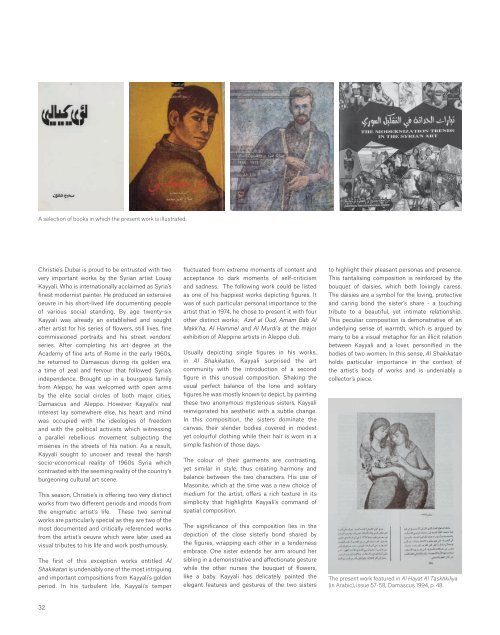NOW AND TEN
DUB1241_SaleCat
DUB1241_SaleCat
Create successful ePaper yourself
Turn your PDF publications into a flip-book with our unique Google optimized e-Paper software.
A selection of books in which the present work is illustrated.<br />
Christie’s Dubai is proud to be entrusted with two<br />
very important works by the Syrian artist Louay<br />
Kayyali. Who is internationally acclaimed as Syria’s<br />
fnest modernist painter. He produced an extensive<br />
oeuvre in his short-lived life documenting people<br />
of various social standing. By age twenty-six<br />
Kayyali was already an established and sought<br />
after artist for his series of fowers, still lives, fne<br />
commissioned portraits and his street vendors’<br />
series. After completing his art degree at the<br />
Academy of fne arts of Rome in the early 1960s,<br />
he returned to Damascus during its golden era,<br />
a time of zeal and fervour that followed Syria’s<br />
independence. Brought up in a bourgeois family<br />
from Aleppo, he was welcomed with open arms<br />
by the elite social circles of both major cities,<br />
Damascus and Aleppo. However Kayyali’s real<br />
interest lay somewhere else, his heart and mind<br />
was occupied with the ideologies of freedom<br />
and with the political activists which witnessing<br />
a parallel rebellious movement subjecting the<br />
miseries in the streets of his nation. As a result,<br />
Kayyali sought to uncover and reveal the harsh<br />
socio-economical reality of 1960s Syria which<br />
contrasted with the seeming reality of the country’s<br />
burgeoning cultural art scene.<br />
This season, Christie’s is ofering two very distinct<br />
works from two diferent periods and moods from<br />
the enigmatic artist’s life. These two seminal<br />
works are particularly special as they are two of the<br />
most documented and critically referenced works<br />
from the artist’s oeuvre which were later used as<br />
visual tributes to his life and work posthumously.<br />
The frst of this exception works entitled Al<br />
Shakikatan is undeniably one of the most intriguing<br />
and important compositions from Kayyali’s golden<br />
period. In his turbulent life, Kayyali’s temper<br />
fuctuated from extreme moments of content and<br />
acceptance to dark moments of self-criticism<br />
and sadness. The following work could be listed<br />
as one of his happiest works depicting fgures. It<br />
was of such particular personal importance to the<br />
artist that in 1974, he chose to present it with four<br />
other distinct works; Azef al Oud, Amam Bab Al<br />
Makk’ha, Al Hammel and Al Murdi’a at the major<br />
exhibition of Aleppine artists in Aleppo club.<br />
Usually depicting single fgures in his works,<br />
in Al Shakikatan, Kayyali surprised the art<br />
community with the introduction of a second<br />
fgure in this unusual composition. Shaking the<br />
usual perfect balance of the lone and solitary<br />
fgures he was mostly known to depict, by painting<br />
these two anonymous mysterious sisters, Kayyali<br />
reinvigorated his aesthetic with a subtle change.<br />
In this composition, the sisters dominate the<br />
canvas, their slender bodies covered in modest<br />
yet colourful clothing while their hair is worn in a<br />
simple fashion of those days.<br />
The colour of their garments are contrasting,<br />
yet similar in style, thus creating harmony and<br />
balance between the two characters. His use of<br />
Masonite, which at the time was a new choice of<br />
medium for the artist, ofers a rich texture in its<br />
simplicity that highlights Kayyali’s command of<br />
spatial composition.<br />
The signifcance of this composition lies in the<br />
depiction of the close sisterly bond shared by<br />
the fgures, wrapping each other in a tenderness<br />
embrace. One sister extends her arm around her<br />
sibling in a demonstrative and afectionate gesture<br />
while the other nurses the bouquet of fowers,<br />
like a baby. Kayyali has delicately painted the<br />
elegant features and gestures of the two sisters<br />
to highlight their pleasant personas and presence.<br />
This tantalising composition is reinforced by the<br />
bouquet of daisies, which both lovingly caress.<br />
The daisies are a symbol for the loving, protective<br />
and caring bond the sister’s share - a touching<br />
tribute to a beautiful, yet intimate relationship.<br />
This peculiar composition is demonstrative of an<br />
underlying sense of warmth, which is argued by<br />
many to be a visual metaphor for an illicit relation<br />
between Kayyali and a lover, personifed in the<br />
bodies of two women. In this sense, Al Shakikatan<br />
holds particular importance in the context of<br />
the artist’s body of works and is undeniably a<br />
collector’s piece.<br />
The present work featured in Al Hayat Al Taskhkiliya<br />
(in Arabic), issue 57-58, Damascus 1994, p. 48.<br />
32


